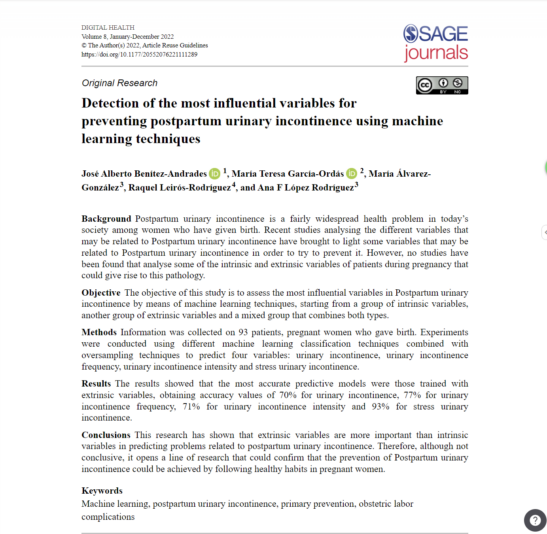Detection of the most influential variables for preventing postpartum urinary incontinence using machine learning techniques
Abstract
Background
Postpartum urinary incontinence is a fairly widespread health problem in today’s society among women who have given birth. Recent studies analysing the different variables that may be related to Postpartum urinary incontinence have brought to light some variables that may be related to Postpartum urinary incontinence in order to try to prevent it. However, no studies have been found that analyse some of the intrinsic and extrinsic variables of patients during pregnancy that could give rise to this pathology.
Objective
The objective of this study is to assess the most influential variables in Postpartum urinary incontinence by means of machine learning techniques, starting from a group of intrinsic variables, another group of extrinsic variables and a mixed group that combines both types.
Methods
Information was collected on 93 patients, pregnant women who gave birth. Experiments were conducted using different machine learning classification techniques combined with oversampling techniques to predict four variables: urinary incontinence, urinary incontinence frequency, urinary incontinence intensity and stress urinary incontinence.
Results
The results showed that the most accurate predictive models were those trained with extrinsic variables, obtaining accuracy values of 70% for urinary incontinence, 77% for urinary incontinence frequency, 71% for urinary incontinence intensity and 93% for stress urinary incontinence.
Conclusions
This research has shown that extrinsic variables are more important than intrinsic variables in predicting problems related to postpartum urinary incontinence. Therefore, although not conclusive, it opens a line of research that could confirm that the prevention of Postpartum urinary incontinence could be achieved by following healthy habits in pregnant women.
1. Benítez-Andrades JA, García-Ordás MT, Álvarez-González M, Leirós-Rodríguez R, López Rodríguez AF. Detection of the most influential variables for preventing postpartum urinary incontinence using machine learning techniques. DIGITAL HEALTH. 2022;8. doi:10.1177/20552076221111289

